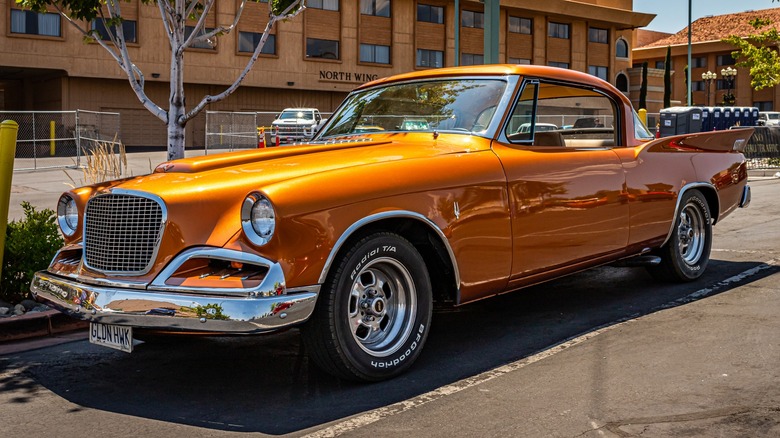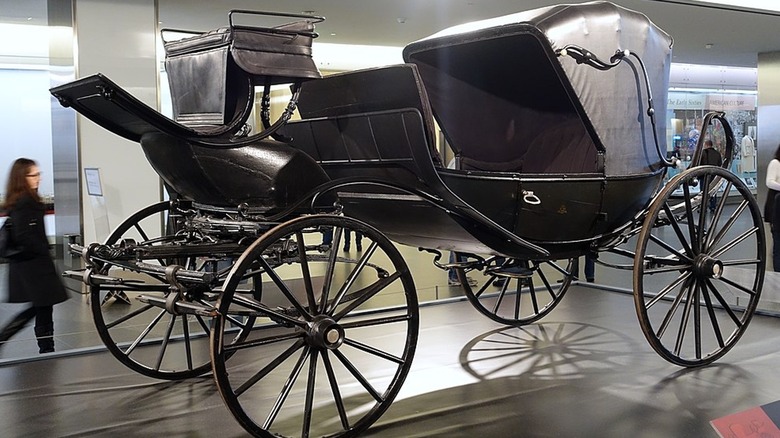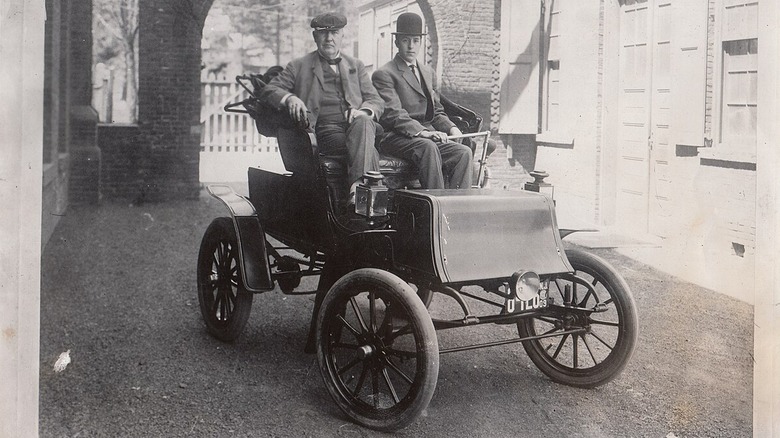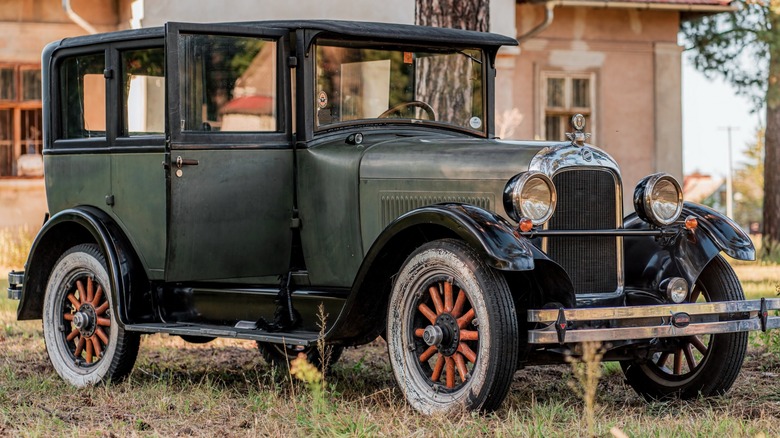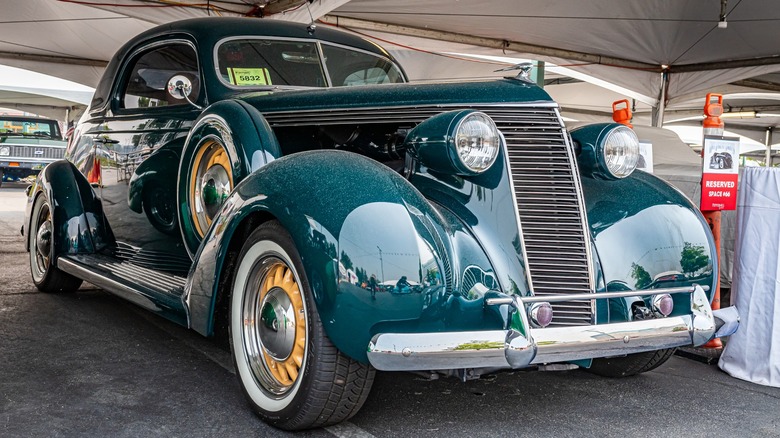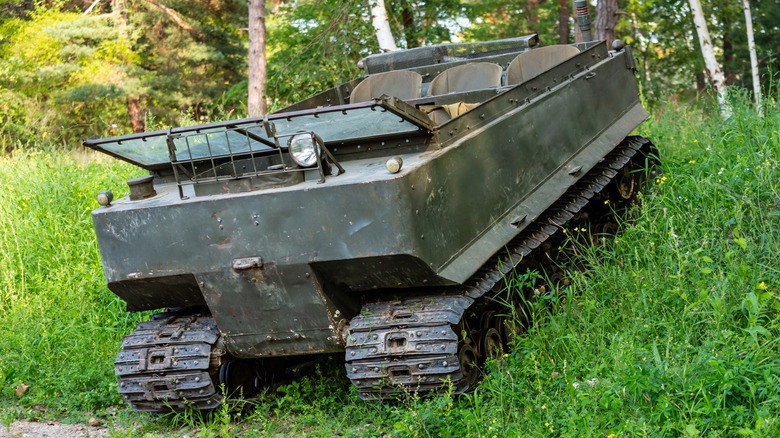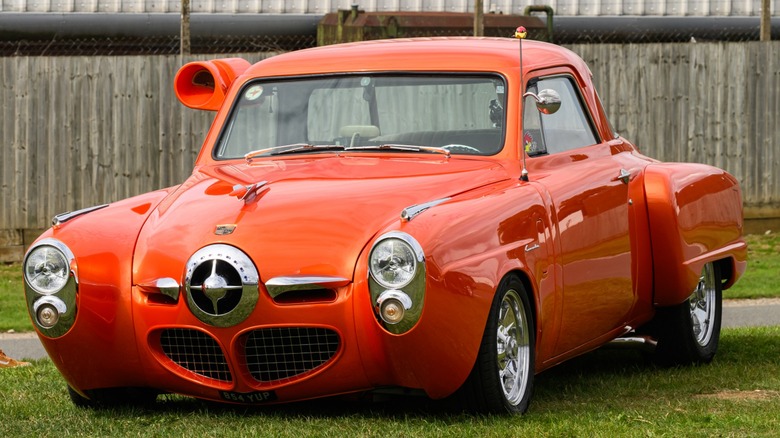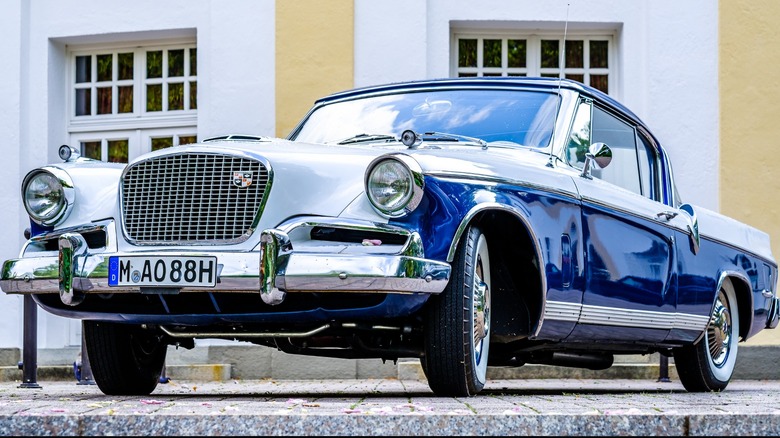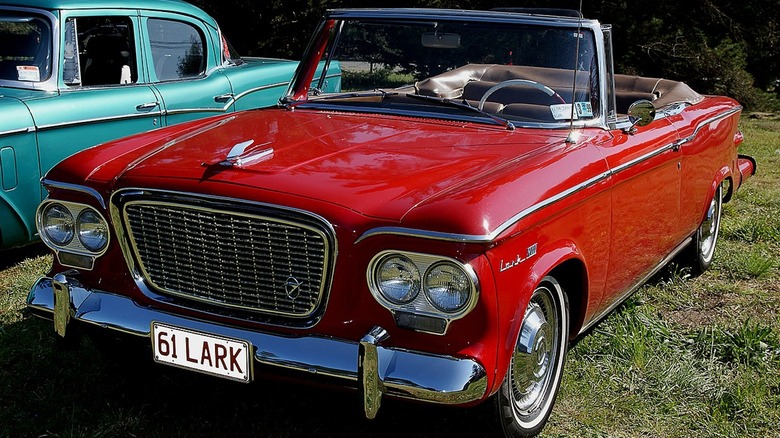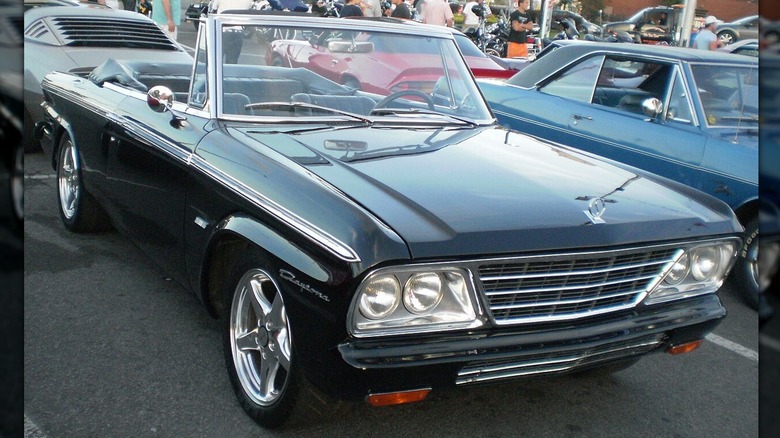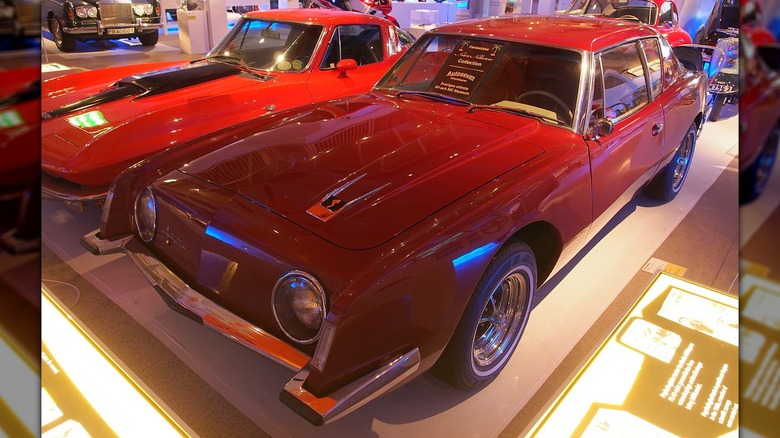What Happened To Studebaker Automobiles?
American drivers today know well the "Big Three" Detroit manufacturers of Chrysler, Ford, and General Motors, who have dominated the auto industry for decades. However, there was once a time when many other automakers produced cars from Detroit and elsewhere, making the American auto business a rich tapestry of entrepreneurs and innovators. Names such as Nash, Duesenberg, Hudson, Marmon, Cord, and even American Motors adorned the hoods of cars from New York to California. But while competition is in general healthy for markets, too much competition can be detrimental, leaving most of these historic marques to go bust at one time or another.
One of the longest holdouts of these historic companies was Studebaker. Once a trusted name in pre-industrialized mobility, the company had transformed itself into a trusted automaker producing dependable cars for the mass market. With a tumultuous ride through the perilous times of the first half of the 20th century, Studebaker remained while so many others folded, only to see its fortunes also dwindle into oblivion. Studebaker was once a proud American company that is now defunct, leaving behind a legacy and a sizable list of antique and classic cars. But now that so many decades have passed, you may be wondering, whatever happened to Studebaker? To answer that question, here is a brief look into the story of the historic automaker.
Studebaker's origins
The Studebaker name goes back much further than Ford, Chevrolet, Renault, or Benz, as it was once affixed to wagons and carriages from the most successful manufacturer of such products in America. Founded in South Bend, Indiana in the 1850s, the Studebaker brother's carriage business quickly grew based on the high quality of their products, which carried all varieties of goods and passengers throughout the young country. With a major boost in business from the Civil War, Studebaker became the premier carriage maker in America, even producing the model that carried the body of Abraham Lincoln to his funeral.
As times changed, so did Studebaker, transitioning from a carriage maker to an automaker around the turn of the century. The early days of automobile development featured many automakers producing battery-powered vehicles, long before Tesla existed. Studebaker's first models were battery-powered cars; gasoline-powered models followed just a couple of years later. For a time, electric, gasoline, and horse-drawn vehicles were produced at the same time in different factories, but by the 1920s, only gasoline-powered vehicles remained in production. The first electric vehicles were designed and manufactured by Studebaker, and the company got its start in producing gasoline-powered cars by acquiring Everett-Metzger-Flanders, which built cars that were sold by Studebaker. After receiving many complaints about quality, Studebaker acquired the company to correct the issues and established the Studebaker Corporation in 1911.
Automobile manufacturing
With the acquisition of an existing automaker complete, the Studebaker Corporation quickly set out to expand its lineup and develop new models with bigger engines and original designs. By 1913, Studebaker was the third largest American automaker, building vehicles in its Detroit plants gained through its acquisitions. Its early electric and single-cylinder models had been replaced by four- and six-cylinder models competitive with the most popular cars of the day. By 1920, horse-drawn carriage production had ended and all manufacturing shifted to its home base in South Bend, Indiana. This would continue to be the location of the company's headquarters until its final days.
Before carriage production ended, Studebaker used its manufacturing prowess to aid in the war effort during WWI. While this conflict had been largely mechanized, horses were still widely used and Studebaker produced horse-drawn ambulances as well as large wooden wheels for mobile artillery. It also built support equipment such as water carts featuring large wagon wheels and metal tanks, of which Studebaker built 10,500.
Expansion and growth
The 1920s was a time of economic expansion for everyone, providing ample opportunities to sell more cars. During this time, bigger was better, and Studebaker's flagship car was the Big Six. Powered by a 353-cubic-inch straight 6-cylinder engine, it proved to be popular for its powerful engine and capability of reaching speeds up to 80 mph. Additionally, the company introduced the Erskine in 1927, an entry-level car meant to tear buyers away from the wildly successful Model T. While the car they built was an attractive package with a reasonably powerful 40-horsepower engine, it proved to be unreliable and much more expensive than its competitors and suffered from poor sales.
As the 1930s approached, Studebaker set its sights higher, developing its first eight-cylinder that would be seen in the new President 8 model of 1928. Seeking to attract luxury buyers, this new car came with a name that sought to associate it with the high aspirations of the office of the same name. Furthermore, Studebaker acquired Pierce-Arrow, one of the "Three Ps" of American luxury, along with Packard and Peerless. While it remained independently manufactured, Pierce-Arrow models gained a much wider Studebaker dealer network. Sadly, the timing of the move toward luxury cars and the acquisition of a luxury brand was terrible, as the Great Depression kicked off soon after this development. With new expensive cars on offer and the failure of its low-price competitor, Studebaker entered one of the darkest chapters in American history on a highly unstable footing.
Struggle to survive the Depression
While many luxury marques flourished during the Depression, Pierce-Arrow floundered and troubles at Studebaker threatened to bring it down. Sales had dipped, and Studebaker entered bankruptcy in 1933. Pierce-Arrow was bought by investors for $1 million in 1933. However, selling its luxury division in no way led Studebaker out of the woods. It was still saddled with a product lineup inconsistent with market demands in a depressed economy.
With the company insolvent, Studebaker's president Alber Erskine was forced out of his position in favor of a more diligent, penny-pinching manager. Sadly, Erskine took this extremely hard and ended his own life shortly after in 1933. Studebaker began introducing new models to return to prosperity. New business in the production of trucks helped to boost revenue. The 1937 Studebaker Coupe-Express introduced a new style of pickup based on a car chassis with a pickup bed long before Chevrolet's El Camino entered production. By 1939, the new low-priced Champion was introduced, bringing a car for the times to Studebaker dealers and continuing to chart a course of profitability for the company. While the future looked good for the company, nobody foresaw what would come next as the tumultuous 1940s arrived.
WWII wartime production
With the declaration of war on Japan, all production of passenger cars ended as the country transitioned to a wartime economy. While Studebaker had once supplied wagons and water carts to the war effort in Europe, this time it would build much more sophisticated military equipment.
At the onset of war, Studebaker had five factories. All of them were converted to military use to produce several vehicles and trucks, as well as the invaluable Wright R-1820 Cyclone radial engines used in B-17 Flying Fortress bombers, one of the best American planes used in the war. Other equipment includes the M29 Weasel, a light-tracked cargo carrier, and 2.5-ton 6x6 heavy trucks. Most of these went to the Soviets as they desperately needed heavy trucks to fortify their logistics. They were initially built with an open cab design, but changed due to feedback from the Soviets who had to endure harsh Russian winters in these trucks. Studebaker had also produced many heavy-duty 4x2 trucks before the outbreak of war, sending them to the Netherlands, France, and Belgium, but most of these were confiscated and used by Germany long before the Americans entered the battle. By the war's end, 218,000 trucks and 63,000 Cyclone engines had been built.
Studebaker's plant on Chippewa Avenue in South Bend continued to be used for military production through the Korean War, and later became part of Kaiser-Willys and then American Motors as AM General. All the while, the same machines continued to be produced by the same crew for years.
Post-war return to civilian production
In the aftermath of WWII, Studebaker advertisements proudly proclaimed, "First by far with a postwar car." Looking to cash in on pent-up demand from a population deprived of consumer goods for the duration of the war, Studebaker worked quickly to beat its competitors with newly styled models. The result of their efforts was the 1947 Champion, which was the first all-new design from an American carmaker — others had cars in '46 and '47, but they were leftover designs from before the war, often with only superficial updates. The new car was a radical design featuring plenty of curves, fully integrated fenders, and a large wrap-around rear glass that made the car look almost as if it were going forward while in reverse.
Successful cars introduced in 1947 gave way to more modern designs as the 1950s arrived. In 1950, Studebaker debuted another radically styled model, the Commander. Its most obvious design element, which was also the most distinctive, was its "bullet nose," which appeared to be influenced by the advancing era of jets and rockets, resulting in a striking front end with unmistakable characteristics. Furthermore, 1951 saw the introduction of an OHV V8 engine and a new automatic transmission. Other new and striking models arrived in 1953, but cracks in Studebaker's foundation began to appear. Quality problems showed up in production models, and improper forecasting led some consumers to wait for orders to be filled, only to head to other brands to pick up existing inventory. This may have been the beginning of the end for Studebaker.
Merger with Packard Motor Car Company
In 1953, talks began on a merger between Studebaker and Packard, two independent automakers struggling to keep up in a fast-changing market. Joining a luxury brand with a mainstream automaker was seen as a great way for both companies to work off of each other's strengths to form one strong unit that could compete on all levels. Sadly, none of that turned out to be true. For better or worse, the merger was completed in 1954.
Packard had initiated the possibility of a merger but only found out after it was complete what a bad idea it was. Studebaker had underestimated its break-even point by 50,000 cars and immediately put Packard in an even worse position than it had been in before the merger. Furthermore, Studebaker's facilities were outdated and it had a workforce that cost the company too much. Despite these issues, Studebaker continued to release new models, including the stylish Golden Hawk. However, Packard found itself on a quick decline as its original models became overtaken by Studebaker models rebadged as Packards.
One last chance for survival
After phasing out Packard completely and finding itself struggling to survive, Studebaker came out with another plan for survival by releasing a car to compete in the compact segment called the Lark. A prior attempt to compete in this space had come with the 1957 to 1958 Scotsman, a no-frills version of the President that offered no extras whatsoever. Despite being as stripped down as possible, the low price brought enough sales to Studebaker to make a case for a cheap car. This led to the 1959 Lark, a new car riding on an old platform and produced to meet a low price over all other considerations.
That the Lark was produced to be cheap does not mean it was a bad car, it just means it was not a great car. Contemporary reviews note that it was the only car in its class to continue being built with body-on-frame construction, as opposed to unibody, and this made it heavy, particularly with a V8 engine, and the weight tended to contribute to poor handling. However, the 259-cubic-inch V8 did provide brisk acceleration thanks to its 180-horsepower output, a considerable improvement over the standard straight-6 engine, which did not even have overhead valves.
Despite introducing its compact before the competition from Detroit and having brisk sales for a couple of years, Larks stopped flying off the shelves after a couple of years, leaving Studebaker back in the same position as before.
The final days of Studebaker
Some of Studebaker's last models looked fantastic. An updated Gran Turismo Hawk moved the brand even more upscale, while refinements to the Lark also gave it a more refined look. The Avanti came out looking to be the luxury sports touring coupe everyone wanted — but they didn't. One of the lesser-known legacies of the Studebaker Corporation is that toward the end of its existence, it used its large dealership network to strike a deal with Mercedes-Benz to be their American distributor, bringing in much-needed revenue and showroom traffic at dual-branded dealerships. However, it was also not meant to be, and the partnership failed in 1964.
Vehicle production ended in South Bend on December 9, 1963, but Studebaker held on for a couple more years. It had for many years manufactured vehicles in Hamilton, Ontario, and continued operations in Canada until 1966. But with dwindling resources on both sides of the border and despite having some new and attractive models such as the Daytona and the Cruiser, the last Studebaker rolled off the line on March 17, 1966. It was the end of an era that had begun before the Civil War.
Retrospective
For those who love automobiles and the culture that surrounds them, the death of a storied brand such as Studebaker is a bit sad. It left behind a treasure trove of transportation history and a smattering of antique and classic cars across the country. Studebaker is unique in that it contributed many models throughout the years without any of them having any profound impact the way the Mustang, Model T, or Thunderbird did. However, some old Studebakers offer a great opportunity for classic car ownership for which there remains a fervent fanbase to draw on for help.
Today, there are about 12,500 members of the Studebaker Drivers Club, an organization dedicated to the brand established back in 1962. Its website offers a wealth of information to support owners and enthusiasts, and memberships even include a subscription to "Turning Wheels," a magazine published exclusively for club members. Many members undoubtedly would love to see a revival for the defunct brand. Alas, Studebaker production ended decades ago. But the memory of the brand and the cars it produced shall remain a part of the rich tapestry of the American story for decades to come.
